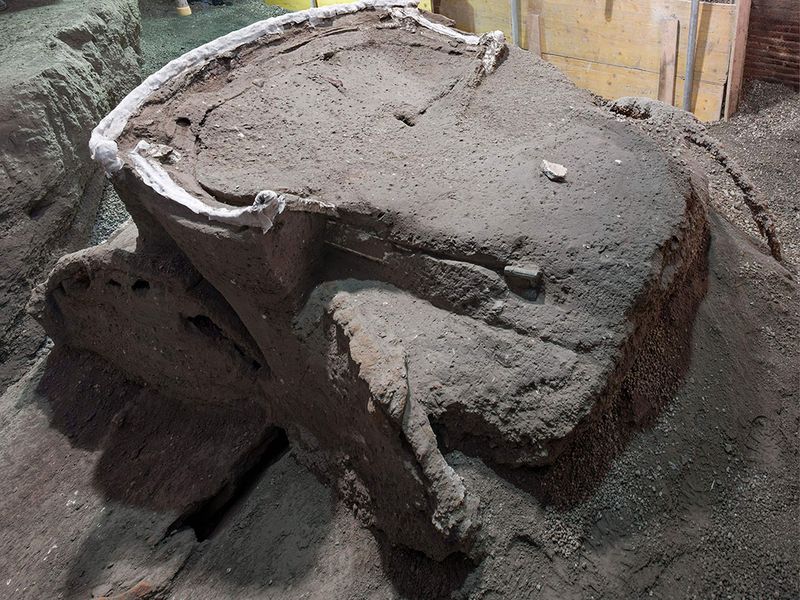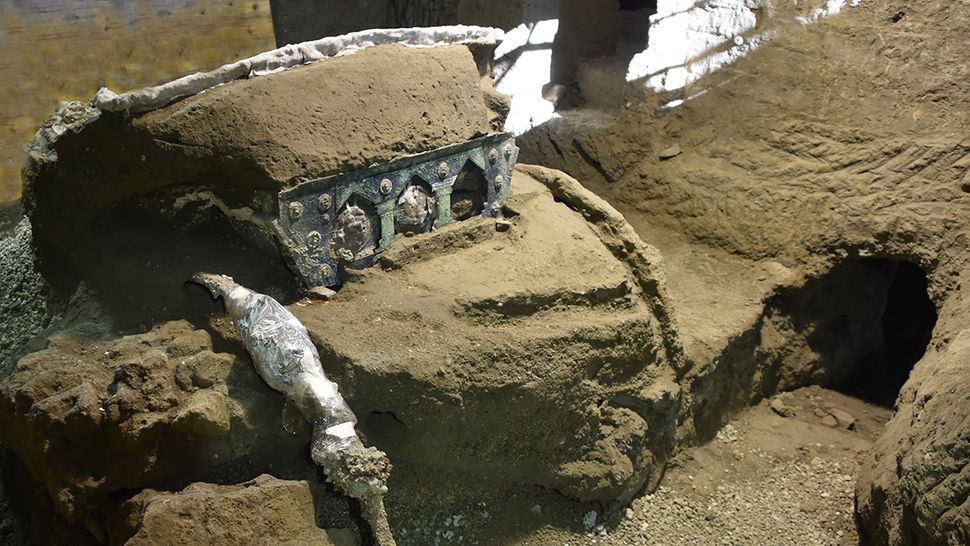Anthropology
Related: About this forumArchaeologists find unique ceremonial vehicle near Pompeii
Well-preserved iron, bronze and tin carriage discovery is ‘without precedent in Italy’
Reuters in Rome
Sat 27 Feb 2021 09.37 EST
Archaeologists have unearthed a unique Roman ceremonial carriage from a villa just outside Pompeii, the city buried in a volcanic eruption in 79 AD.
The almost perfectly preserved four-wheeled carriage, made of iron, bronze and tin, was found near the stables of an ancient villa at Civita Giuliana, about 700 metres north of the walls of ancient Pompeii.
Massimo Osanna, the outgoing director of the Pompeii archaeological site, said the carriage was the first of its kind discovered in the area, which had so far yielded functional vehicles used for transport and work, but not for ceremonies.
“This is an extraordinary discovery that advances our understanding of the ancient world,” Osanna said, adding that the carriage would have accompanied festive moments for the community, such as parades and processions.
More:
https://www.theguardian.com/science/2021/feb/27/archaeologists-find-unique-ceremonial-vehicle-near-pompeii
~ ~ ~
The large Roman four-wheeled ceremonial chariot was discovered in a porch in front of a stable.
HANDOUT / AFP - Getty Images
Ancient ceremonial carriage uncovered by archaeologists near Pompeii
Feb. 27, 2021, 10:05 AM CST
By Reuters
ROME — Archaeologists have unearthed a unique ancient-Roman ceremonial carriage from a villa just outside Pompeii, the Italian city buried in a volcanic eruption in 79 AD.
The almost perfectly preserved four-wheeled carriage made of iron, bronze and tin was found near the stables of an ancient villa at Civita Giuliana, around 700 meters north of the walls of ancient Pompeii.
Massimo Osanna, the outgoing director of the Pompeii archaeological site, said the carriage was the first of its kind discovered in the area, which had so far yielded functional vehicles used for transport and work, but not for ceremonies.
"This is an extraordinary discovery that advances our understanding of the ancient world," Osanna said, adding that the carriage would have "accompanied festive moments for the community, (such as) parades and processions".
A large Roman four-wheeled ceremonial chariot was
discovered near the archaeological park of Pompeii.
HANDOUT / AFP - Getty Images
More:
https://www.nbcnews.com/news/world/ancient-ceremonial-carriage-uncovered-archaeologists-near-pompeii-n1259067
~ ~ ~
Photos: Archaeologists uncover ancient ceremonial carriage near Pompeii
The culture ministry called it 'a unique find, without any precedent in Italy'
Published: February 27, 2021 18:44
Reuters

Rome: Archaeologists have unearthed a unique ancient-Roman ceremonial carriage from a villa just outside Pompeii, the city buried in a volcanic eruption in 79 AD.
Image Credit: AFP
More:
https://gulfnews.com/photos/news/photos-archaeologists-uncover-ancient-ceremonial-carriage-near-pompeii-1.1614437575373?slide=8
Judi Lynn
(163,980 posts)By Tom Metcalfe - Live Science Contributor an hour ago

The wooden platform and shaft of the chariot have now rotted away; to preserve the artifacts' shapes, archaeologists injected plaster into the voids they left in the hardened ash. (Image credit: Archaeological Park of Pompeii)
An ornate four-wheeled chariot of iron, bronze and wood that archaeologists think was drawn by a team of horses in processions through Pompeii almost 2,000 years ago has been unearthed during excavations of a wealthy Roman villa just north of the ancient city’s walls.
Archaeologists discovered the elaborate chariot, which still has imprints of organic materials such as its ropes and floral decorations, almost intact in a portico of the villa in the suburb of Civita Giuliana, facing the stables where the remains of three horses were found in 2018.
The collapsing walls and roof of the villa helped preserve the chariot from 21st-century antiquities thieves, who had dug tunnels at the site that nearly reached the chariot, according to officials at the Archaeological Park of Pompeii, which is managed by Italy's cultural heritage ministry.
It's thought the richly-adorned chariot may have been a pilentum referred to by some sources, which was not for everyday use or for agricultural transport, but featured in community festivities, parades, and processions. It's the first time that this type of ceremonial chariot has been found in Italy, the statement said.
More:
https://www.livescience.com/chariot-unearthed-pompeii-astounds-archaeologists.html?utm_source=notification

